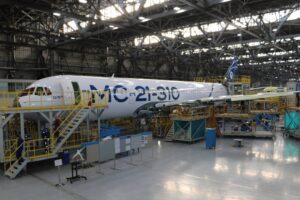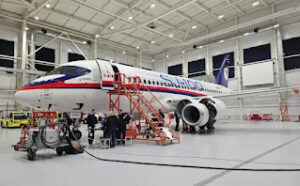 |
| MC-21 Stand |
Two important pieces of news have been announced by the Russian authorities. Significant tests started at the Irkutsk Aviation Plant for the first completely import-substituted MC-21 aircraft (MC-0013). All of the airliner’s systems are currently being inspected by specialists. The first phase, which involves the inspection of the electrical supply, is nearing its end.
Furthermore, representatives of PJSC Yakovlev stated that the prototype SSJ-100 aircraft, 95157, is currently undergoing ground engine tests with the PD-8 engine, while the first serial aircraft, 97004, has been connected for power.
The manufacturers note that the work on MC-21 is progressing rapidly and successfully as a result of the established collaboration with component suppliers and developers, as well as the experience gained from the assembly of previous aircraft.
Verifying all operational modes, evaluating functionality under a variety of emergency scenarios (failure simulations), and powering up the aircraft are all components of the electrical system check. The testing of additional aircraft systems, including hydraulics, flight control, and radio communication, will commence in the near future.
The Electrical Systems Check is the primary focus of the Ground Testing phase of new aircraft testing. The aircraft’s systems are powered up and tested during this critical phase, which happens while the aircraft is on the ground. The objective is to guarantee that all electrical systems, including power distribution, avionics, and emergency scenarios, operate properly before the initiation of more sophisticated testing phases.
The MC-21 aircraft’s testing procedure is expected to involve multiple stages following the electrical systems check. To begin, Integrated Systems Testing will evaluate the seamless operation of a variety of systems, including hydraulics, flight control, radio communication, and navigation systems. The aircraft’s capacity to manage emergencies will be confirmed through the ongoing testing of simulated failure scenarios. Next, the aircraft will be subjected to Ground Vibration Testing (GVT) to verify its dynamic behavior and structural integrity. This is followed by Engine Runs and Taxi Tests, which involve the aircraft’s engines being started and tested at varying power levels while the aircraft is on the ground. Taxi tests involve the aircraft being moved on the runway at varying speeds to evaluate the braking, steering, and other ground-handling systems.
The First Flight of the aircraft will take place upon the effective completion of all ground tests. This is a significant milestone that marks the initial assessment of the aircraft’s airworthiness. The aircraft’s performance, handling, and systems will be assessed under a variety of conditions, including varying altitudes, speeds, and weights, through a series of Flight tests that will follow the maiden flight. Stability, controllability, and compliance with aviation regulations are also assessed during this phase. To satisfy the certification standards of the Federal Agency for Air Transport (Rosaviatsiya), the aircraft is subjected to a rigorous Certification Testing process. This encompasses the demonstration of safety, reliability, and performance standards. Operational Testing is a process that involves the aircraft being tested in real-world conditions, frequently involving airline pilots and crew, before delivery. This process is designed to ensure that the aircraft is suitable for commercial service and meets operational requirements. Ultimately, the aircraft is shipped to customers and enters commercial service after successfully completing all testing phases.
 |
| SJ-100 with PD-8 Engine |
Meanwhile, an off-site meeting on external cooperation took place on February 7, 2025, by representatives of the United Aircraft Corporation at the aircraft facility in Komsomolsk-on-Amur, where the final assembly of Sukhoi Superjet regional passenger aircraft is conducted. The event convened representatives of Russian enterprises that are active in the collaboration to develop an import-substituted version of this highly sought-after civil aviation aircraft.
The timeline for the new version of the Superjet program is the primary concern. 11 serial airframes have been assembled and will be furnished with domestic systems and components after certification, according to published reports. The first serial aircraft, 97004, has already been connected to power, while the prototype aircraft with the number 95157 is being prepared for ground engine runs with the PD-8 engine, according to representatives of PJSC Yakovlev. Certification flight tests are scheduled to commence in 2025, and preparations are underway to guarantee uninterrupted mass production following the aircraft’s certification with new engines and onboard systems.
Modernization initiatives are currently ongoing at the Superjet production facility in 2025. Production has commenced in a logistics center, and the final assembly workshop is being expanded to accommodate a straight-line conveyor. Additionally, an additional hangar for two aircraft is being built. The aircraft plant is making every effort to guarantee that mass production of the new aircraft can commence in the necessary quantities thereafter, following the completion of testing.
Official Website of Youtube Channel – Altitude Addicts

